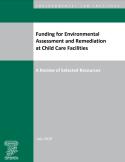
Research Reports
ELI publishes Research Reports available for free download that present the analysis and conclusions of the policy studies ELI undertakes to improve environmental law and policy. These reports contribute to education of the profession and disseminate diverse points of view and opinions to stimulate a robust and creative exchange of ideas. Those publications, which express opinions of the authors and not necessarily those of the Institute, its Board of Directors, or funding organizations, exemplify ELI’s commitment to dialogue with all sectors.
Particulate matter (PM) is an air pollutant that has been linked to a wide range of serious health effects, including cardiovascular and respiratory symptoms and disease, as well as neurological and endocrine disorders.
Read More >
Co-digestion of food wastes with wastewater solids at water resource recovery facilities (WRRFs) can provide financial benefits to WRRFs as well as a broad range of environmental and community benefits. Co-digestion is a core element of the wastewater sector’s “Utility of the Future” initiative, which envisions a new business approach for pioneering WRRFs to create valuable energy and nutrient products via the recovery and reuse of residuals from the wastewater treatment process.
Read More >
The American West, including the cities of Las Vegas, Nevada; Los Angeles, California; Phoenix, Arizona; and Denver, Colorado, falling under the reaches of the greater Colorado River Basin (CRB), is now among the world's water stressed regions facing the environmental, economic, and social challenges of increased water scarcity. The CRB supplies more than 1 in 10 Americans with some, if not all, of their water for municipal use, including drinking water.
Read More >
This report is the culmination of a three-month investigation into the nature of 3d-printing with regards to potential social and environmental implications. Three graduate students from the Sustainability Innovation MBA program at the University of Vermont teamed up with members of the Environmental Law Institute to identify these implications and offer recommendations for sustainability within the specific sector of maker-spaces in the 3d-printing industry.
Read More >
Environmental site hazards at a child care facility may arise from contamination of the air, soil, or water caused by historical uses of the property or nearby activities. Identifying and remedying such hazards is important for limiting harmful indoor and outdoor exposures to children and staff. The costs involved, however, can present challenges for child care operators, especially those serving historically underserved communities.
Read More >